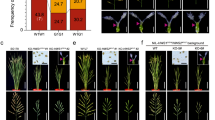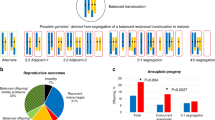Abstract
The reproductive features of wild all-acrocentric and 2n = 22 Robertsonian (Rb) house mice (M. m. domesticus) from Tunisia were studied. The aim was to examine the possibility of a reproductive selective advantage associated with chromosomal change as well as to measure the effect of heterozygosity for a large number of Rb fusions on the fertility of hybrids. Results showed that litter sizes were significantly smaller in Rb than in all-acrocentric mice. This difference, which may represent a favourable demographic strategy related to the habitat segregation observed in the Tunisian mice, needs to be studied further. The F1 hybrids between the two chromosomal races showed a significantly reduced reproductive success and litter size (respectively, 53 per cent and 60 per cent less than either parental race). Analysis of the testicular histology of F1 and backcross males showed in some cases a breakdown of spermatogenesis. The degree of this disturbance was not related to the level of chromosomal heterozygosity suggesting that genetic incompatibilities between the two genomes might be involved. The strong reduction in fertility measured in these hybrids represents a reproductive isolating mechanism effectively reducing gene flow between the all-acrocentric and 22Rb mice populations of Tunisia.
Similar content being viewed by others
Article PDF
References
Barton, N H, and Rouhani, S. 1991. The probability of fixation of a new karyotype in a continuous population. Evolution, 45, 499–517.
Britton-Davidian, J, Nadeau, J H, Croset, H, and Thaler, L. 1989. Genie differentiation and origin of Robertsonian populations of the house mouse (Mus musculus domesticus L.). Genet Res, 53, 29–44.
Capanna, E. 1982. Robertsonian numerical variation in animal speciation: Mus musculus, an emblematic model. In: Liss, A. R. (ed.) Mechanisms of Speciation, pp. 155–177.
Cattanach, B M, and Moseley, H. 1973. Nondisjunction and reduced fertility caused by the tobacco mouse metacentric chromosomes. Cytogenet Cell Genet, 12, 264–287.
Elder, F E B, and Pathak, S. 1980. Light microscopic observations on the behavior of silver-stained trivalents in pachytene cells of Sigmodon fulvidenter (Rodentia, Muridae) heterozygous for centric fusions. Cytogenet Cell Genet, 27, 31–38.
Garagna, S, Redi, C A, Zuccotti, M, Britton-Davidian, J, and Winking, H. 1990. Kinetics of oogenesis in mice heterozygous for Robertsonian translocations. Differentiation, 42, 167–171.
Gropp, A, and Winking, H. 1981. Robertsonian translocations: cytology, meiosis, segregation pattern and biological consequences of heterozygosity. Symp Zool Soc London, 47, 141–181.
Gropp, A, Winking, H, and Redi, C. 1982. Consequences of Robertsonian heterozygosity: segregational impairment of fertility versus male-limited sterility. In: Crosignani, P. G. and Rubin, S. (eds) Genetic Control of Gamete Production and Function, Academic Press, New York, pp. 115–134.
Haaf, T, Winking, H, and Schmid, M. 1989. Immunocytogenetics. III. Analysis of trivalent and multivalent configurations in mouse pachytene spermatocytes by human antibodies to synaptonemal complexes and kinetochores. Cytogenet Cell Genet, 50, 14–22.
Lecornu, F, Lebourbouac'H, P, Milan, J J, and Cognat, M. 1984. Que penser du T.M.I.? Score d'interpretation de l'histopathologie testiculaire. In: Arvis, G. and Dadoune, J.-P. (eds) La Biopsie Testiculaire, SIMEP, Lyon-Villeurbanne, pp. 34–39.
Lee, M R, and Elder, F F B. 1980. Yeast stimulation of bone marrow mitosis for cytogenetic investigation. Cytogenet Cell Genet, 26, 36–40.
Mahadevaiah, S K, Setterfield, L A, and Mittwoch, U. 1990. Pachytene pairing and sperm counts in mice with single Robertsonian translocations and monobrachial compounds. Cytogenet Cell Genet, 53, 26–31.
Michalakis, Y, and Olivieri, I. 1993. The influence of local extinctions on the probability and time to fixation of chromosomal rearrangements. J Evol Biol, 6, 153–170.
Moses, M J, Karatsis, P A, and Hamilton, E A. 1979. Synaptonemal complex analysis of heteromorphic trivalents in Lemur hybrids. Chromosoma, 70, 141–160.
Redi, C A, and Capanna, E. 1978. DNA-content variation in mouse spermatozoa arising from irregular meiotic segregation. Boll Zool, 45, 315–322.
Redi, C A, and Capanna, E. 1988. Robertsonian heterozygotes in the house mouse and the fate of their germ cells. In: Riss, A. R. (ed.) The Cytogenetics of Mammalian Rearrangements, pp. 315–359.
Redi, C A, Garagna, S, Hilscher, B, and Winking, H. 1985. The effects of some Robertsonian chromosome combinations on the seminiferous epithelium of the mouse. J Embryol exp Morph, 85, 1–19.
Said, K, Jacquart, T, Montgelard, C, Sonjaya, H, Helal, A N, and Britton-Davidian, J. 1986. Robertsonian house mouse populations in Tunisia: a karyological and biochemical study. Genetica, 68, 151–156.
Said, K, and Britton-Davidian, J. 1991. Genetic differentiation and habitat partition of Robertsonian house mouse populations (Mus musculus domesticus) of Tunisia. J Evol Biol, 4, 409–427.
Sites, J W, Jr., and Moritz, C. 1987. Chromosomal evolution and speciation revisited. Syst Zool, 36, 153–174.
Spirito, F. 1992. The exact values of the probability of fixation of underdominant chromosomal rearrangements. Theor Pop Biol, 41, 111–120.
Spirito, F, Rossi, C, and Rizzoni, M. 1991. Populational interactions among underdominant chromosomal rearrangements help them persist in small demes. J Evol Biol, 4, 501–512.
Viroux, M C, and Bauchau, V. 1992. Segregation and fertility in Mus musculus domesticus (wild mice) heterozygous for the Rb(4.12) translocation. Hered, 68, 131–134.
Wallace, B M N, and Searle, J. 1990. Synaptonemal complex studies of the common shrew (Sorex araneus). Comparison of Robertsonian heterozygotes and homozygotes by light microscopy. Hered, 65, 359–367.
Wallace, B M N, Searle, J B, and Everett, C A. 1992. Male meiosis and gametogenesis in wild house mice (Mus musculus domesticus) from a chromosomal hybrid zone; a comparison between ‘simple’ Robertsonian heterozygotes and homozygotes. Cytogenet Cell Genet, 61, 211–220.
White, M J D. 1968. Models of speciation. Science, 159, 1065–1070.
Winking, H, Dulic, B, and Bulfied, G. 1988. Robertsonian karyotype variation in the European house mouse, Mus musculus. Survey of present knowledge and new observations. Z Säugertierkunde, 53, 148–161.
Winking, H, and Gropp, A. 1976. Meiotic non-disjunction of metacentric heterozygotes in oocytes versus spermatocytes. In: Crosignani, P. G. and Mishell, D. R. (eds) Ovulation in the Human: Proceedings of the Serono Symposium vol. 8, Academic Press, pp. 47–56.
Author information
Authors and Affiliations
Rights and permissions
About this article
Cite this article
Said, K., Saad, A., Auffray, JC. et al. Fertility estimates in the Tunisian all-acrocentric and Robertsonian populations of the house mouse and their chromosomal hybrids. Heredity 71, 532–538 (1993). https://doi.org/10.1038/hdy.1993.172
Received:
Issue date:
DOI: https://doi.org/10.1038/hdy.1993.172
Keywords
This article is cited by
-
Measurements of hybrid fertility and a test of mate preference for two house mouse races with massive chromosomal divergence
BMC Evolutionary Biology (2019)
-
Impact of the number of Robertsonian chromosomes on germ cell death in wild male house mice
Chromosome Research (2015)
-
Origin of the chromosomal radiation of Madeiran house mice: a microsatellite analysis of metacentric chromosomes
Heredity (2013)
-
Chromosomal evolution in tenrecs (Microgale and Oryzorictes, Tenrecidae) from the Central Highlands of Madagascar
Chromosome Research (2007)
-
Contact zones between chromosomal races of Mus musculus domesticus. 3. Molecular and chromosomal evidence of restricted gene flow between the CD race (2n = 22) and the ACR race (2n = 24)
Heredity (2002)



